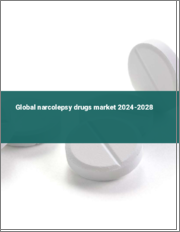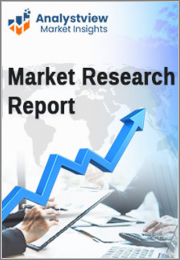
|
시장보고서
상품코드
1566200
세계의 기면증 치료제 시장 규모, 점유율, 성장 분석, 질병 유형별, 치료제 유형별, 지역별 시장 규모, 점유율, 성장 분석 - 산업 예측(2024-2031년)Narcolepsy Drugs Market Size, Share, Growth Analysis, By Disease Type (Daytime Extreme Sleepiness, Cataplexia), By Therapeutics Type (Central Nervous System Stimulants, Tricyclic Antidepressants), By Region - Industry Forecast 2024-2031 |
||||||
세계 기면증 치료제 시장 규모는 2022년 약 34억 달러로 평가되었습니다. 2023년 37억 달러에서 2023년 37억 달러로 증가하여 예측 기간(2024-2031년) 동안 9.5%의 연평균 복합 성장률(CAGR)로 2031년 70억 달러에 달할 것으로 예상됩니다.
수면무호흡증 치료제 시장은 의료가 필요한 만성 질환과 급성 질환에 걸리기 쉬운 고령화 등 몇 가지 중요한 요인으로 인해 크게 성장할 것으로 예상됩니다. 기면증 장애 증가는 생활양식의 변화와 스트레스 수준 증가로 인해 악화되고 있으며, 향후 몇 년동안 시장 확대에 더욱 박차를 가할 것으로 예상됩니다. 연구 이니셔티브 강화, 의료 지출 증가, 의료 인프라 개선이 이러한 성장 잠재력을 뒷받침하고 있습니다. 또한, 생체리듬 조절, 수면 시간 증가, 재택근무 등의 요인이 중추성 과수면증과 관련된 증상을 효과적으로 관리할 수 있음을 시사하고 있어, 기면증 치료제가 널리 받아들여질 것으로 예상됩니다. 그러나 치료 및 진단과 관련된 높은 비용과 사용 가능한 치료법에 대한 전반적인 인식 부족은 시장 성장을 저해하는 요인으로 작용할 수 있습니다. 불리한 상환 환경도 큰 걸림돌로 작용하고 있으며, 이는 표적화된 연구개발에 집중하는 제약사들의 수익 기회에 영향을 미칠 수 있습니다. 이러한 도전에도 불구하고 미국 시장 상황은 향후 예측 기간 동안 안정적인 CAGR을 나타낼 것으로 예상됩니다. 이는 수면 관련 질환이 점점 더 우선순위가 높아지는 의료 환경의 변화 속에서 치료에 대한 수요가 견고하게 유지되고 있음을 반영합니다.
목차
서론
- 조사 목적
- 정의
- 시장 범위
조사 방법
- 정보 조달
- 2차 데이터 소스와 1차 데이터 소스
- 시장 규모 예측
- 시장 상정과 제한
주요 요약
- 시장 개요 전망
- 공급 수요 동향 분석
- 부문별 기회 분석
시장 역학과 전망
- 시장 역학
- 성장 촉진요인
- 기회
- 성장 억제요인
- 과제
- Porter의 Five Forces 분석
주요 시장 인사이트
- 주요 성공 요인
- 경쟁 정도
- 주요 투자 기회
- 시장 생태계
- 규제 분석
- 사례 연구 분석
- 임상시험
기면증 치료제 시장 : 질환 유형별
- 시장 개요
- 주간 극도 졸음
- 탈력증
- 기타 질환 유형
기면증 치료제 시장 : 치료제 유형별
- 시장 개요
- 중추신경 자극제
- 삼환계 항우울제
- Sodium Oxybate
- 선택적 세라토닌 재흡수 억제제
- 기타 치료 유형
기면증 약 시장 규모 : 지역별
- 시장 개요
- 북미
- 미국
- 캐나다
- 유럽
- 독일
- 스페인
- 프랑스
- 영국
- 이탈리아
- 기타 유럽
- 아시아태평양
- 중국
- 인도
- 일본
- 한국
- 기타 아시아태평양
- 라틴아메리카
- 브라질
- 기타 라틴아메리카
- 중동 및 아프리카(MEA)
- GCC 국가
- 남아프리카공화국
- 기타 중동 및 아프리카
경쟁 구도
- 주요 5개사 비교
- 주요 기업의 시장 포지셔닝(2023년)
- 주요 시장 기업이 채택한 전략
- 시장에서의 최근 활동
- 주요 기업의 시장 점유율(2023년)
주요 기업 개요
- Jazz Pharmaceuticals plc
- Teva Pharmaceutical Industries Ltd.
- Bioprojet Pharma SARL
- Novartis International AG
- Takeda Pharmaceutical Company
- Avadel Pharmaceuticals
- Mylan N.V.(now part of Viatris)
- Aurobindo Pharma
- Glenmark Pharmaceuticals
- Lupin Pharmaceuticals
- Otsuka Pharmaceutical
- Biogen
- Theravance Biopharma
- Ligand Pharmaceuticals
- Flamel Technologies(now Avadel Pharmaceuticals)
- Biocodex
- Sun Pharmaceutical Industries
- Cipla Limited
- Dr. Reddy's Laboratories
- Pfizer Inc.
Global Narcolepsy Drugs Market size was valued at around USD 3.4 billion in 2022 and is expected to rise from USD 3.7 billion in 2023 to reach a value of USD 7 billion by 2031, at a CAGR of 9.5% over the forecast period (2024-2031).
The narcolepsy therapeutics market is poised for substantial growth driven by several key factors, primarily the aging population's increased susceptibility to chronic and acute ailments necessitating medical care. The rise in narcoleptic disorders, exacerbated by evolving lifestyles and heightened stress levels, is expected to further fuel market expansion in the coming years. Enhanced research initiatives, increased healthcare spending, and improved medical infrastructure underscore this growth potential. Additionally, factors such as circadian adjustment, increased sleep, and telework practices suggest that symptoms associated with central hypersomnia can be effectively managed, encouraging a broader acceptance of narcolepsy treatments. However, challenges exist, notably the high costs associated with treatments and diagnostics, coupled with an overarching lack of awareness regarding available therapies, which are likely to hinder market progress. The unfavorable reimbursement landscape also poses significant obstacles, potentially impacting revenue opportunities for pharmaceutical companies focused on targeted research and development. Despite these challenges, the US narcolepsy drugs market is expected to experience a steady compound annual growth rate (CAGR) over the next forecast period, reflecting a resilient demand for treatments amid an evolving healthcare landscape that increasingly prioritizes sleep-related disorders.
Top-down and bottom-up approaches were used to estimate and validate the size of the Global Narcolepsy Drugs market and to estimate the size of various other dependent submarkets. The research methodology used to estimate the market size includes the following details: The key players in the market were identified through secondary research, and their market shares in the respective regions were determined through primary and secondary research. This entire procedure includes the study of the annual and financial reports of the top market players and extensive interviews for key insights from industry leaders such as CEOs, VPs, directors, and marketing executives. All percentage shares split, and breakdowns were determined using secondary sources and verified through Primary sources. All possible parameters that affect the markets covered in this research study have been accounted for, viewed in extensive detail, verified through primary research, and analyzed to get the final quantitative and qualitative data.
Global Narcolepsy Drugs Market Segmental Analysis
Global Narcolepsy Drugs Market is segmented by Disease Type, Therapeutics Type, and region. Based on Disease Type, the market is segmented into Daytime Extreme Sleepiness, Cataplexia, and Other Disease Type. Based on Therapeutics Type, the market is segmented into Central Nervous System Stimulants, Tricyclic Antidepressants, Sodium Oxybate, Selective Serotonin Reuptake Inhibitor, and Other Therapeutic Type. Based on region, the market is segmented into North America, Europe, Asia Pacific, Latin America and Middle East & and Africa.
Driver of the Global Narcolepsy Drugs Market
Growing awareness surrounding narcolepsy treatment plays a crucial role in driving the Global Narcolepsy Drugs market from 2023 to 2030. As more patients and healthcare providers recognize the impact of the condition on quality of life, the demand for effective treatments is surging. Notably, the preference for modafinil, which is known for its favorable safety profile compared to traditional stimulants, is further contributing to this trend. This increased focus on appropriate therapeutic options not only enhances patient outcomes but also fosters market growth, as effective therapies become more widely adopted, driving sales and innovation within the narcolepsy drug sector.
Restraints in the Global Narcolepsy Drugs Market
A significant market restraint for the global narcolepsy drugs market is the frequent misdiagnosis of narcolepsy symptoms, which are often confused with various mental and neurological disorders. This lack of awareness leads to inappropriate prescriptions of antiepileptics and psychiatric medications, particularly in children and adolescents, potentially causing adverse health effects. The resulting hesitation from healthcare providers to accurately diagnose and treat narcolepsy can hinder market growth, as patients may not receive the necessary therapy for their condition. Additionally, this confusion can create mistrust among patients towards seeking effective treatments, further limiting market opportunities for narcolepsy drug manufacturers.
Market Trends of the Global Narcolepsy Drugs Market
The global narcolepsy drugs market is poised for significant growth, fueled by the rising prevalence of narcolepsy and associated sleep disorders across diverse demographics. Increasing incidences of obesity-related narcolepsy variants further bolster market expansion, highlighting the pressing need for effective therapeutic solutions. Government initiatives aimed at enhancing awareness and understanding of narcolepsy are anticipated to drive demand for treatment options. Moreover, hospitals are emerging as the primary end-use sector, capturing the largest share of the market as more patients seek specialized care. Overall, this confluence of factors positions the narcolepsy drugs market for robust growth in the coming years.
Table of Contents
Introduction
- Objectives of the Study
- Definitions
- Market Scope
Research Methodology
- Information Procurement
- Secondary & Primary Data Sources
- Market Size Estimation
- Market Assumptions & Limitations
Executive Summary
- Market Overview Outlook
- Supply Demand Trend Analysis
- Segmental Opportunity Analysis
Market Dynamics & Outlook
- Market Dynamics
- Drivers
- Opportunities
- Restraints
- Challenges
- Porters Analysis
- Competitive rivalry
- Threat of Substitute Products
- Bargaining Power of Buyers
- Threat of New Entrants
- Bargaining Power of Suppliers
Key Market Insights
- Key Success Factor
- Degree of Competition
- Top Investment Pockets
- Ecosystem of the Market
- Regulatory Analysis
- Case Study Analysis
- Clinical Trials
Narcolepsy Drugs Market, By Disease Type
- Market Overview
- Daytime Extreme Sleepiness
- Cataplexia
- Other Disease Type
Narcolepsy Drugs Market, By Therapeutics Type
- Market Overview
- Central Nervous System Stimulants
- Tricyclic Antidepressants
- Sodium Oxybate
- Selective Serotonin Reuptake Inhibitor
- Other Therapeutic Type
Narcolepsy Drugs Market Size by Region
- Market Overview
- North America
- USA
- Canada
- Europe
- Germany
- Spain
- France
- UK
- Italy
- Rest of Europe
- Asia Pacific
- China
- India
- Japan
- South Korea
- Rest of Asia-Pacific
- Latin America
- Brazil
- Rest of Latin America
- Middle East & Africa (MEA)
- GCC Countries
- South Africa
- Rest of MEA
Competitive Landscape
- Top 5 Player Comparison
- Market Positioning of Key Players, 2023
- Strategies Adopted by Key Market Players
- Recent Activities in the Market
- Key Companies Market Share (%), 2023
Key Company Profiles
- Jazz Pharmaceuticals plc
- Company Overview
- Business Segment Overview
- Financial Updates
- Key Developments
- Teva Pharmaceutical Industries Ltd.
- Company Overview
- Business Segment Overview
- Financial Updates
- Key Developments
- Bioprojet Pharma SARL
- Company Overview
- Business Segment Overview
- Financial Updates
- Key Developments
- Novartis International AG
- Company Overview
- Business Segment Overview
- Financial Updates
- Key Developments
- Takeda Pharmaceutical Company
- Company Overview
- Business Segment Overview
- Financial Updates
- Key Developments
- Avadel Pharmaceuticals
- Company Overview
- Business Segment Overview
- Financial Updates
- Key Developments
- Mylan N.V. (now part of Viatris)
- Company Overview
- Business Segment Overview
- Financial Updates
- Key Developments
- Aurobindo Pharma
- Company Overview
- Business Segment Overview
- Financial Updates
- Key Developments
- Glenmark Pharmaceuticals
- Company Overview
- Business Segment Overview
- Financial Updates
- Key Developments
- Lupin Pharmaceuticals
- Company Overview
- Business Segment Overview
- Financial Updates
- Key Developments
- Otsuka Pharmaceutical
- Company Overview
- Business Segment Overview
- Financial Updates
- Key Developments
- Biogen
- Company Overview
- Business Segment Overview
- Financial Updates
- Key Developments
- Theravance Biopharma
- Company Overview
- Business Segment Overview
- Financial Updates
- Key Developments
- Ligand Pharmaceuticals
- Company Overview
- Business Segment Overview
- Financial Updates
- Key Developments
- Flamel Technologies (now Avadel Pharmaceuticals)
- Company Overview
- Business Segment Overview
- Financial Updates
- Key Developments
- Biocodex
- Company Overview
- Business Segment Overview
- Financial Updates
- Key Developments
- Sun Pharmaceutical Industries
- Company Overview
- Business Segment Overview
- Financial Updates
- Key Developments
- Cipla Limited
- Company Overview
- Business Segment Overview
- Financial Updates
- Key Developments
- Dr. Reddy's Laboratories
- Company Overview
- Business Segment Overview
- Financial Updates
- Key Developments
- Pfizer Inc.
- Company Overview
- Business Segment Overview
- Financial Updates
- Key Developments



















